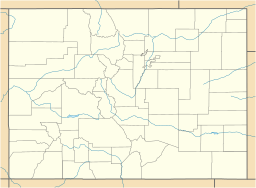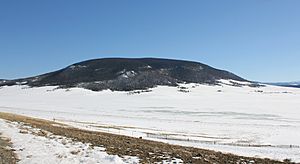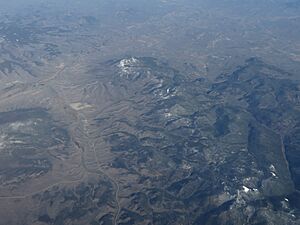San Juan volcanic field facts for kids
Quick facts for kids San Juan volcanic field |
|
|---|---|
| Highest point | |
| Geography | |
| Location | Colorado, United States |
| Geology | |
| Mountain type | Volcanic field |
The San Juan volcanic field is a large area in the San Juan Mountains of southwestern Colorado. It is made mostly of volcanic rocks. This area is the biggest part left of a huge volcanic field that once covered much of the southern Rocky Mountains. This happened during a time called the Middle Tertiary period.
Scientists know of about 15 calderas in the San Juan Volcanic Field. There might even be a few more hidden in the area. This region started with many large volcanoes that became active between 35 and 40 million years ago. Their busiest time was around 35 to 30 million years ago. During this time, the volcanoes began to have powerful eruptions that shot out ash. Many of these volcanoes later had their tops collapse inwards. This created the 15 to 18 caldera volcanoes we see there today. A caldera is a large, bowl-shaped hollow that forms when the ground above a magma chamber collapses after an eruption.
Contents
How the Volcanoes Changed Over Time
The San Juan volcanic field had two main periods of volcanism, which is when volcanoes are active.
Early Volcanic Activity
The first period of volcanic activity happened during the Oligocene age. This was part of the Palaeogene Period, a very long time ago. During this time, the volcanoes produced a lot of lava and broken rock pieces called breccias. They also created ash flow tuffs. Tuff is a type of rock made from volcanic ash. These rocks formed as the melted rock, or magma, changed deep underground.
One example of these early volcanic rocks is the Conejos Formation. You can find it in the southeastern part of the field. Even after the big caldera eruptions, the volcanoes kept producing these types of rocks. The Huerto Andesite is another example of a large amount of this early volcanic rock.
Later Volcanic Activity
The second period of volcanic activity happened later, from the Miocene to the Pliocene ages. These are part of the Neogene Period. This time was different because the volcanoes produced two very different types of lava. They made both thin, runny lava with low silica and thick, sticky rhyolite lava with high silica.
Scientists think this later lava came from melted rock deep within the Earth's crust. It then erupted onto the surface.
Important Calderas in the Area
The San Juan volcanic field has many calderas. Here are some of the most well-known ones:
| Name | Associated tuff | Coordinates | Age |
|---|---|---|---|
| Lake City | Sunshine Peak Tuff | 38°02′N 107°23′W / 38.03°N 107.38°W | 22.93 ± 0.02 Ma |
| Creede Caldera | Snowshoe Mountain Tuff | 37°46′N 106°56′W / 37.76°N 106.94°W | 26.5 ± 0.3 Ma |
| Cochetopa | Nelson Mountain Tuff | 38°12′N 106°45′W / 38.2°N 106.75°W | 26.4 ± 0.5 Ma |
| San Luis | Cebolla Creek Tuff Rat Creek Tuff |
38°01′N 107°58′W / 38.01°N 107.97°W | 26.9 Ma |
| South River | Watson Park Tuff | 37°40′N 106°56′W / 37.67°N 106.94°W | 27.4? Ma |
| Bachelor | Carpenter Ridge Tuff | 37°49′N 106°55′W / 37.82°N 106.91°W | 27.45 ± 0.05 Ma |
| La Garita | Fish Canyon Tuff | 37°46′N 106°56′W / 37.76°N 106.94°W | 27.45 ± 0.05 Ma |
| Uncompahgre-San Juan | Sapinero Mesa Tuff | 37°58′N 107°32′W / 37.96°N 107.53°W | 27.5 ± 0.5 Ma |
| Platoro | Treasure Mountain Group | 37°21′N 106°32′W / 37.35°N 106.53°W | 28.4 Ma |
| Unknown | Masonic Park Tuff | 37°42′N 106°41′W / 37.70°N 106.69°W | 28.7 Ma |
| North Pass | Saguache Creek Tuff | 38°12′N 106°32′W / 38.20°N 106.54°W | 32.2 Ma |
| Bonanza | Bonanza Tuff | 38°19′N 106°05′W / 38.32°N 106.08°W | 33.12 ± 0.03 Ma |
| Marshall | Thorn Ranch Tuff | 38°20′N 106°14′W / 38.34°N 106.23°W | 33.6 ± 0.3 Ma |
Mining and Resources
The San Juan volcanic field has been a very important place for mining. People have found and dug up lead, zinc, copper, gold, and silver here. These valuable metals were mostly found inside and near the calderas. This is because the calderas had a lot of activity even after the big eruptions.
The metal ores were found in cracks in the rocks. These cracks were made by the caldera activity. They were also found in new rock formations that pushed up after the calderas formed. The most metals were found near the newest and most silica-rich rock formations from each caldera cycle.
See also
 In Spanish: Campo volcánico de San Juan para niños
In Spanish: Campo volcánico de San Juan para niños





